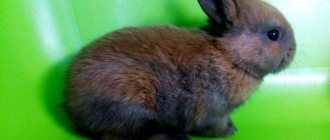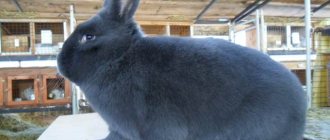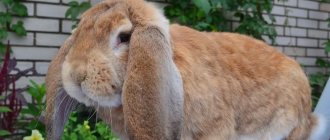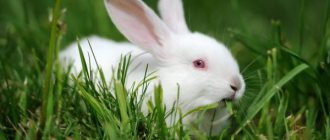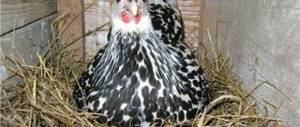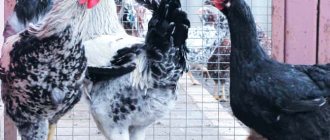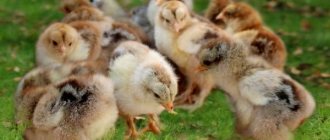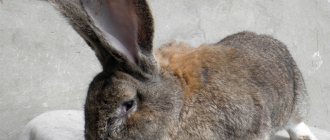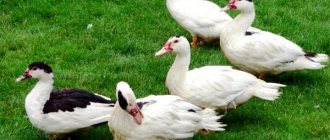History of origin
Today, much remains unknown in the history of the origin of the described breed. However, the date is reliable - in 1800 this species originated. In England, active work began on obtaining Dutch rabbits.
Numerous mutations occurred in the rabbit's genes, and the animals acquired unusual external qualities - red eyes, white, soft fur, a strong body. Then the mutating individuals were repeatedly crossed. In Amsterdam in 1947, an exhibition was held at which scientists presented the results of their work - Dutch rabbits.
Description of the breed
At first, this species was usually classified as a meat-and-skin species; on average, the live weight of one rabbit could reach 5.5 kg. After breeding broiler breeds, Dutch rabbits move into the decorative category, as they have acquired more compact sizes.
Its peaceful disposition and unusual appearance made it very popular among breeders.
External data
Representatives of the described breed have the following appearance characteristics:
- strong body of compact size;
- large and strong hind legs compared to the front ones;
- on average, the weight ranges from 1.4-1.8 kg, but some animals can reach 3 kg;
- the neck does not have clearly defined outlines;
- short ears, covered with hair;
- chubby cheeks;
- the head is not large, the muzzle is slightly flattened;
- soft and thick fur, not too long;
- fur color is the main feature of the breed - the back of the body is dark, the front is white;
- There are individuals whose fur has three shades;
- eyes can be brown or blue-gray;
- The average life expectancy is 8-11 years.
Color
Animals can have fur of a wide variety of interesting colors. Dutchies are among the rarest species, with more than 25 different fur color options available today. There are traditional colors, as well as ash blue, deep red, black and white, silver gray, etc.
Watch the video review of the Dutch rabbit:
Due to its high quality and non-standard color options, Dutch fur is in great demand in the production of natural fur products.
Weight
In an adult, live weight can vary between 4-6 kg. The physique is muscular and quite strong. The animals grow quickly and rapidly gain weight, so by the age of 5 months they are ready for slaughter if they are raised for meat products.
Character
The Dutch are friendly and affectionate animals and have an easygoing disposition. Sociable, brave and inquisitive, which is why they differ from other decorative species. Ideal for being a pet. Another feature of the Dutch character is that they are quick learners, so they can be easily trained to use a litter box, which makes cleaning much easier.
Characteristics
The photo shows the Dutch rabbit in all its glory. He has a beautiful, proportionally built body, long ears (22-27 cm).
By the way, regarding the latter, we note that rabbits are not immediately born with fold ears, this happens in the first month of their life or, in extreme cases, at the beginning of the second. The rabbit has a short body, its length in relation to head size is 2:1 (usually in commercial breeds this ratio is 3:1). The rabbit has a compact build and well-developed muscles.
An adult animal has broad shoulders that smoothly merge into a well-developed back; it has the same wide, fleshy croup. In adult females, a slight dewlap is allowed. The large head is set high on a short neck, which is covered with plush short fur. Short muzzle with full cheeks, eyes well spaced. Their life expectancy with proper care is about 8 years.
Read also: How to disinfect rabbit cages at home?
A Dutch ram, upon reaching the age of 6 months (junior), must weigh at least 900 g, otherwise it will not be allowed to exhibit. An adult animal aged 1.5 years, according to UK standards, cannot weigh more than 1.6 kg, and according to American standards - 1.8 kg. The ideal weight of a Dutch decorative rabbit should be about one and a half kilograms.
Initially, the main color of the Dutch ram was dark tortoiseshell, which is also called Madagascar. And today it is this variety that remains the most common, in the form of the spotted tortoiseshell or tortoiseshell variant. Later, a huge number of different colors were developed, which can be divided into 8 main groups:
- Plain: blue, lilac, black, chocolate white with red or blue eyes.
- Shaded: Siamese sable, point sable, smoky pearl, seal. Tortoiseshells - blue, purple, black, chocolate.
- Agouti: chinchilla chocolate and chinchilla, chocolate and chestnut, lynx and squirrel, opal.
- Tan: blue, lilac otter, chocolate, black.
- Wideband: Cream, Frost, Red, Orange, Fawn, Tricolor.
- Pointed: blue, chocolate, black and lilac.
- Ticked: silver or golden ticked steel in variations of chocolate, lilac, blue, black.
- Spotted: Any of the above with white color.
Dutch Fold rabbits are very affectionate and friendly animals. They are braver and more sociable than other breeds of decorative rabbits; they are ideal as pets for families with small children; they are also excellent as show animals. When keeping such animals at home, children need to be explained how to properly handle animals so that they do not cause harm to the big-eared animal through carelessness or ignorance. A positive quality of these animals is that they become toilet trained quite quickly and easily.
Maintenance and care
The Dutch are not whimsical, but in order for the animal to feel comfortable, certain conditions must be created. First of all, you need to take care of purchasing and arranging the cage in which the rabbit will live.
Selection and arrangement of the cage
Make sure that the animal’s house meets the following characteristics:
- the cage is quite spacious - approximately 70-50 cm;
- do not leave the cage near heaters or in the sun, as rabbits do not tolerate heat well;
- do not leave the cage in a draft;
- Cover the bottom of the cage with straw, hay or sawdust;
- Attach a drinking bowl to the side grill so that the rabbit has constant access to water (read here about how to make a drinking bowl yourself);
- choose heavy feeders that the animal cannot turn over;
- In the cage, equip a place to rest and a toilet.
Rules of care
Regular cleaning of the cage allows you to maintain your pet's health in perfect condition. Every day, remove food debris and clean the tray, change the bedding, and regularly add fresh water.
Perform a thorough cleaning approximately every 7-10 days:
- Move the rabbit to a safe place and remove all bedding and any remaining food.
- Clean the cage thoroughly with a stiff-bristled brush. Use a toothbrush to brush all hard-to-reach areas.
- Wash the cage with warm water using a vinegar solution (water and vinegar in equal quantities) or plain soap. Finally, rinse thoroughly with clean water.
- As soon as the cage is thoroughly dry, lay out new bedding, pour water and add food.
- Always leave a small unkempt corner or part of the old litter. The fact is that animals have the habit of marking their home; if they do not smell their scent, they will behave restlessly.
When cleaning, do not use chemicals. If left in the cage, they can cause serious health problems for your rabbit.
Preventive vaccinations
Regular preventive vaccinations help maintain the rabbit's health in ideal condition. Try to adhere to the following frequency:
- up to 45 days, vaccination against myxomatosis is given;
- at 4.5 months, re-vaccination is carried out and is done every six months in the future;
- at 2 months of age he is vaccinated against rabies.
To avoid a decrease in immunity, carry out prophylaxis against helminths before each vaccination.
Caring for the Dutch breed of rabbits
Some features of keeping rabbits may depend on their breed, therefore, when bringing an animal into the house, it is worth asking how the pets of your chosen breed should be cared for.
Care
Caring for the Dutch breed of rabbits includes:
- Keeping the cage clean.
- Opportunity to periodically spend time in the fresh air.
- Keeping the animal clean.
The animal's cage should always be clean. The sawdust should be renewed at least once every 3 days. If there is a separate toilet in the cage, the filler in it is changed every other day. Rabbits are very clean, and failure to maintain hygiene can lead to a shortened life or the appearance of diseases. You should wash the bowl regularly before feeding. The drinking bowl must also be kept clean.
It is not recommended to bathe the rabbit itself.
In case of urgent need, when the animal is very dirty, you can buy it in the washbasin under a light stream of warm water, after which the rabbit is wiped dry.
Bathing is stressful for the animal, so bathing procedures should be carried out extremely rarely. There is no need to care for the fur in other ways - the Dutch rabbit cleans its own skin.
The pet must be released from the cage at least once a week. If it's a warm season outside, you can take your rabbit outside. In winter, you should not let him out of the room. Decorative rabbits need to move and walks outside the cage will have a beneficial effect on the health of the pet.
Once a month, your Dutch rabbit needs to have its nails trimmed. For this purpose, special nail clippers for rodents are used. It is necessary to trim nails to avoid injuring your pet with your own claws and, accordingly, to prevent the occurrence of infectious skin diseases. If you can’t buy a nail clipper, you can use regular nail scissors.
Feeding
Dutch rabbits have powerful, sharp incisors. Thanks to this, the animals can easily eat solid food. Besides, it is vital for them. Your rabbit's diet should always include solid vegetables or fruits. The most suitable are:
- apples;
- carrot;
- cabbage;
- beet.
These products can be used to make salads or serve them fresh, whole.
The Dutch rabbit can be given grain mixtures. A mixture of various seeds and grains will be an excellent variety for a rabbit's diet. In spring and summer, rabbits will happily feast on dandelions, clover and other herbs.
In winter, when it is not the season for herbs, vegetables and fruits, you can buy special food for the Dutch rabbit at pet stores. They will help to avoid hypovitaminosis in the spring and will constantly maintain the rabbit’s health at a high level.
It is recommended to feed the Dutch rabbit 2-3 times a day in small portions to avoid obesity. But fasting is contraindicated for a rabbit.
Breeding
Breeding Dutch rabbits is no different from breeding other breeds. Except for the fact that dwarf rabbits give birth to about 4 babies at a time. Pregnancy lasts 1 month; human assistance to a pregnant rabbit consists only of creating optimal comfortable conditions for her.
Childbirth often occurs at night and lasts no more than half an hour. The first birth can be problematic - the birth of stillborn rabbits, the mother’s refusal to recognize the children, or the rabbits being too weak. But in subsequent pregnancies there are no problems. Rabbits are born healthy and alive.
After birth, the rabbits must be with their mother. She feeds them with her milk for several weeks. Separating rabbits from the female is possible only after the babies reach two months of age.
The first mating between rabbits occurs when they reach four months of age. It is imperative to ensure that the female and male are born from different parents.
Major diseases
Rabbits of the Dutch breed are susceptible to infectious and non-infectious diseases. The most common pathology is obesity. It is associated with improper care and feeding of the pet.
When overeating or eating the wrong diet, rabbits begin to gain excess weight, which ultimately leads to obesity.
The consequences of this pathology are severe - cardiovascular diseases, skeletal problems, changes in the functioning of the gastrointestinal tract.
By the way, do you know anything about giant rabbits? Look, it's interesting!
In addition to obesity, the Dutch are susceptible to viral hemorrhagic disease. This is an infectious pathology that is transmitted by airborne droplets, food or feces. But this pathology can be prevented through vaccination. The disease is scary because no treatment has yet been developed for it. As a result, the mortality rate is almost 100%.
Through fleas and ticks, the Dutch rabbit runs the risk of contracting myxomatosis. The disease is infectious in nature. There is treatment for this disease, but it is very difficult. Therefore, the mortality rate exceeds 90%. To prevent the disease, vaccination is carried out. Also, the animal should be regularly examined for the presence of ticks and undergo preventive treatment against them.
(1 5,00 of 5) Loading...
Source: //lovelyhamster.ru/kroliki/ukhod-za-gollandskoy-porodoy-krolikov/
Features of feeding
The Dutch diet should include:
- compound feed, which contains all valuable minerals and vitamins;
- oats with corn;
- dried grass - about 250 g per day per individual;
- dandelion with nettle;
- fruits and vegetables;
- brewer's yeast, as it contains a large amount of amino acids and vitamins;
- salt and chalk (feed).
We recommend reading the article - how, when and what to feed rabbits.
What to feed?
If you provide a Dutch rabbit with good living conditions and the right diet, he can live in a family from 6 to 10 years. The animal's diet includes:
Carrots are good for rabbits
- Compound feed. Special food for rabbits contains protein, fats, carbohydrates in the correct proportion, and also contains vitamins and microelements.
- Hay. Dried herbs should be constantly available. Rabbits usually eat an armful of hay every day, about 150-300 grams. This is rough food, thanks to which animals wear down their teeth.
- Fresh greens. Dill, parsley, nettle, plantain, dandelion, legumes are useful additions to the diet.
- Vegetables. The Dutch rabbit happily eats fresh carrots, zucchini, Jerusalem artichokes, and sugar beets.
The decorative Dutch rabbit should not be given:
- red beets;
- wet grass;
- poisonous or unknown plants;
- confectionery;
- fresh bread;
- meat.
Important! In winter, it is advisable to introduce vitamin supplements into your pet’s diet, which will help maintain immunity.
Having decided to get a decorative Dutch rabbit, you need to realize that the pet requires a lot of attention. He is not in excellent health, like all purebred animals. At the first sign of illness, the animal will have to be taken to the veterinarian, otherwise it will die. A miniature eared dog can bring a lot of joy to its owners, but in return it requires love and care.
Breeding
When planning to breed Dutchies, you need to purchase a male and a female. At one time, a female rabbit can give birth to approximately 7-9 babies. During the year, pregnancy occurs 6-8 times. Start mating no earlier than the animals reach 7 months of age. Animals older than 3 years are not suitable for breeding.
When the hunt begins, the female’s behavior changes – she becomes too nervous and begins to pluck her fur. During this period, she needs to be placed in the same cage with the male. The duration of pregnancy is about 30 days. Before giving birth, the female builds a “nest” from her own plucked wool; you can also equip a queen cell for her in advance.
What you need to know
It is optimal to get a dwarf rabbit when it is 3-4 months old, and you can easily determine the gender
It is important to remember that the female rabbit’s character is always more pleasant and calm than that of the male.
The life expectancy of pets, depending on the breed, with proper care, is from 6 to 12 years. Because of this, it is worth immediately assessing whether the rabbit is ready for such a long stay in the family.
You cannot buy an animal without knowing how long dwarf rabbits live. If the ability to keep an animal for a long time is in doubt, you should not get a decorative rabbit; a change of owners can kill him, which means passing a pet from hand to hand is unacceptable.
Breed profitability
Rabbits not only make good pets, but also have beautiful fur. Rabbit skins are widely used to produce expensive fur products. The Dutch are sources of excellent, tender and dietary meat.
Females can give birth to up to 10 rabbits at a time. The young animals grow quickly and rapidly gain weight. Therefore, representatives of the described breed are used both for meat products and skins. Fur is used as a secondary product and is in great demand.
Advantages and disadvantages
The main advantages of the described breed of rabbits are:
- miniature size, so they can be kept in small cages;
- not picky about food;
- ease of care and cultivation;
- learns quickly and can use the tray;
- non-aggressive and flexible disposition;
- beautiful appearance.
However, there are some disadvantages of the breed:
- the cage and other accessories for care and maintenance are expensive;
- the animal’s house must be cleaned every day and the freshness of the water must be constantly monitored;
- animals have a tendency to chew everything around, so he should not be allowed to walk around the apartment unattended;
- a specific aroma may appear;
- Shedding occurs regularly and during this period more attention is required to be paid to the pet.
At night, animals can show increased activity, which interferes with a peaceful rest.
Dutch lop-eared dwarf decorative rabbit ram, description and photo
Dwarf rabbits are excellent, picky pets that, while living peacefully in cages, do not damage furniture or other household items, as is often the case with cats or dogs. This article will discuss a detailed description of the Dutch lop-eared sheep rabbit and the features of keeping the animal at home.
Story
The Dutch Fold rabbit breed is quite popular in the modern world. Breeder Adrian de Kock began the breeding process in 1952.
The selection was quite complicated, since the main problem in breeding dwarf breeds of lop-eared rabbits is that in the process of reducing the size of the animals, the ears also decrease, so it is very difficult to achieve lop-earedness.
Breeds such as the Dutch ram and the common rabbit were used for crossing, but the results were not achieved the first time. The selection process lasted 11 long years. Official recognition of the breed took place in 1964.
Description of the breed
Different breeds of decorative rabbits differ not only in appearance, but also in character, and have certain advantages and disadvantages that you need to become familiar with.
Breed standard
Each breed of decorative dwarf lop-eared rabbits has its own characteristic appearance features that allow it to be distinguished from other breeds. Therefore, let us consider a detailed description of the breed standard in the form of a table.
| Appearance | Characteristic |
| Color | White, black, grey, brown, beige. Can combine several colors and their shades |
| Weight | Up to 1.5 kg |
| Torso | Cylindrical in shape, with a broad chest, short neck, rounded rear |
| Head | Massive, with a wide convex forehead, plump cheeks |
| Paws | The front legs are short and thick, the hind legs are long and thinner. |
| Tail | Miniature, fits snugly to the body |
| Ears | Long - 21–28 cm, hanging |
| Eyes | Large, widely set |
| Claws | Small, strong and sharp |
| Fur length | Up to 1.5 cm |
Character
Rabbits of this breed are very calm, quickly adapt to new living conditions, get along well with people, and therefore are ideally suited for keeping at home as pets. They are happy to be held, let themselves be petted, and love active games.
Despite the fact that rabbits themselves are shy animals, Dutch fold sheep are quite brave and are not afraid of sharp sounds (this is due to a physiological feature - drooping ears, which muffle the sound a little).
Advantages and disadvantages
- Among the advantages of ram rabbits are:
- miniature size, which makes it possible to keep them in small apartments;
- ease of care and pickiness in nutrition;
- quick adaptation to the tray when going to the toilet, which greatly simplifies the cleaning process;
- flexible, non-aggressive character;
- beautiful decorative appearance.
- Disadvantages of keeping the breed include:
- the high cost of the cage and all related accessories for keeping and caring for the pet;
- the need for daily cleaning of the rabbit’s home, regular monitoring of food and water;
- the pet’s tendency to chew through everything that gets in its way (this fact is taken into account when organizing a walk for the pet outside the cage);
- specific smell;
- regular molting, which forces you to clean in and around the cage several times a day;
- pet activity at night, which can interfere with restful rest.
Content Features
Like any other pets, rabbits must be provided with their own home and all the necessary attributes for a normal existence.
Cell
To make rabbits feel comfortable, it is necessary to arrange a corner for them. To do this, you should purchase a suitable cage.
The size of the home for this breed is of great importance, since rabbits are quite active creatures and they need free space to be active during the day, so it is better to choose a cage that is at least 70 cm long and 50 cm wide. Also find out what kind of mesh is needed for a cage for rabbits.
Since a rabbit’s usual habitat in the wild is a burrow, the cage must be equipped with a closed house, where the animal will spend most of the day at first, adapting to the new conditions of detention.
In such a house the animal will feel comfortable and protected. It is better if the cage has two floors: on the top floor the animal will rest and sleep, and on the first floor it will eat and be active. Sawdust in granules or compressed in a special way is poured onto the bottom of the cage.
It is better to place the house with the rabbit in a secluded place, with good lighting, and protection from drafts. The optimal temperature for keeping is from +10 to +20 °C. It is better to maintain the air humidity in the room at 60%.
Dwarf lop-eared rams are quite disciplined about going to the toilet and are accustomed to doing this in a certain corner of the cage. Therefore, before installing the tray, it is better to observe the animal and calculate the “right” angle. Special corner or regular cat litter boxes can be used as a toilet.
For food and water, heavy ceramic dishes (special containers) are used, which can be purchased in specialized stores. Such dishes are necessary so that rabbits cannot chew or turn them over.
Important! The air temperature must not rise above +25 °C, in which case the animal will feel uncomfortable and may get sick.
Rules of care
The breed has not very long soft wool, so it is quite easy to care for. During the period of natural shedding of animals (spring and autumn), it is recommended to comb the fur using a soft brush. This procedure will prevent rabbits from swallowing fur while grooming themselves. The procedure is performed once a week.
In addition to cleaning the fur, it is also necessary to pay attention to the animal’s ears and clean them regularly. The procedure should be performed at least 3 times a week. To do this, use a cotton pad soaked in peroxide. It is also necessary to trim your pet’s nails at least once every two months using special nail clippers.
Feeding
The basis of good health and well-being is high-quality, balanced nutrition. It is recommended to give small rabbits, up to 6 months of age, only grain and grain mixtures, once or twice a day, depending on age (up to one year, give 2 times a day, in small portions, after 1 year - once a day, in the morning ).
The basis of the diet of rabbits of any age is hay. It is poured in sufficient quantity so that the rabbits have something to chew throughout the day. From 7 months of age, rabbits are introduced to the diet of vegetables and fruits:
- apples;
- carrot;
- asparagus;
- broccoli;
- cucumbers;
- bananas;
- celery;
- cauliflower;
- spinach;
- tomatoes;
- green turnips
A mineral stone is also added to the diet, which serves as a source of essential vitamins and microelements. Usually the stone is attached to the bars of the cage to make it easier for the rabbit to chew on it. In addition to food, there should always be clean, fresh water in the cage. It is better to give water at room temperature and regularly change it to clean water.
Possible diseases
Dutch Fold sheep can get sick:
- viral hemorrhagic disease - infection occurs through contact with a sick animal;
- gastrointestinal stasis, which occurs as a result of stress, poor diet or wool ingestion;
- urinary dermatitis, which is characterized by hair loss in the genital area and on the hind legs, redness of the skin;
- coccidiosis, which occurs in an animal under the influence of parasites, in this case a very high mortality rate;
- myxomatosis, which is characterized by loss of appetite, heavy breathing, swelling of the eyelids, pus in the eyes; the disease is transmitted by fleas and lice;
- pasteurellosis - infection occurs after contact with sick animals, the disease is characterized by decreased appetite, rapid breathing, and diarrhea.
We recommend learning how to treat coccidiosis in rabbits.
Vaccinations
Typically, rabbits are vaccinated against myxomatosis and viral hemorrhagic disease. The first vaccination is given when the animal has reached the age of 45 days and has a weight of 500 g. The vaccination can be purchased at a veterinary pharmacy; it is usually comprehensive (against both diseases).
If you were unable to purchase a complex vaccine, then first you are given an injection against myxomatosis, and after 10 days - against hemorrhagic disease. The next vaccination is carried out at the age of 4.5 months, then the vaccine is administered every six months.
If you plan to travel with a rabbit, then it must be vaccinated against rabies and included in its veterinary passport, as airport or train station employees will check its availability.
Features of reproduction
When breeding decorative dwarf lop-eared rabbits, the sex of the individuals is first determined. This can be done no earlier than 4 months of age.
In order to find out the sex, the individuals are turned over on their backs and the tail is pulled back: if in front of you is a male, then you will notice small tubercles, and at a distance of 4 mm from the anus there will be a round genital opening, while in females there is a gap near the anus.
Rabbits can reproduce throughout the year (females give birth from 6 to 9 times), with each litter containing from 2 to 16 cubs. The female feeds the babies with milk for 30–45 days. You can start breeding when individuals are already 7 months old, and females must breed at least once before 12 months of age. Rabbits are suitable for mating up to 3 years of age.
For mating, a female is placed next to the male, and the female rabbit assembles a nest of hay before mating. A good result can be obtained if you plant the male in the first half of the day. After the female has given birth, re-mating can be carried out already on the second day.
Rabbits are born hairless, blind and deaf, but with a well-developed sense of balance and smell. The first fur on the body appears a week after birth, and within 2 weeks the babies develop a beautiful fur coat.
After the same time after birth, the rabbits begin to hear and see. Rabbits can leave the nest at 3 weeks of age. It is necessary to separate young animals from the female rabbit at the age of two months.
Thus, keeping decorative Dutch dwarf lop-eared rabbits at home is not difficult. In order for pets to be healthy and delight you with a beautiful appearance, they are provided with good living conditions and proper care according to the recommendations in the article.
Source: //fermer.blog/bok/zhivotnye/kroliki/porody-krolikov/porody-dekorativnyh-krolikov/795-gollandskij-vislouhij-krolik.html
Reviews
★★★★★
Marina, 35 years old, housewife, Moscow. I spent a long time choosing a rabbit to keep in my apartment and decided to take a Dutch one.
My pet is already 5 years old, but he still remains mobile, active and playful. He greets me with joy when I return home, loves sweets, but categorically refuses carrots. Does not require special care, but gives a lot of positive emotions. ★★★★★
Evgeniy, 28 years old, economist, Voronezh. For me, the rabbit of this breed has become the best animal.
He feels great in a cage, loves to play with children, has an interesting and unusual color, which is why he was chosen. It is easy to care for, just clean the cage regularly and feed it properly. Hide
Add your review
The Dutch rabbit is one of the most sought after representatives of this species. Ideal for keeping in an apartment. It is not fussy in care and nutrition, so its cultivation does not cause any particular difficulties, even for those who have not encountered these animals before.
0
0
Copy link
Dutch dwarf rabbit - small and distinguished
There is no person on Earth who would not be touched by little rabbits.
Many owners would like these fluffy lumps to always fit in the palm of their hand.
Today this problem has been resolved - we have mini-breeds of rabbits, most of which are smaller copies of large breeds.
Such rabbits are kept at home not only for aesthetic purposes: they are an ornamental animal – a friend and family member.
One of these representatives of dwarf breeds is the Dutch rabbit .
Peculiarities
Since the rabbit is an exact copy of its big older brother, the classic color is considered to be a white and black body with colored circles around the eyes.
There are also colored spots on the ears and hind legs in the form of socks.
The color of the rabbit resembles a tuxedo , so it looks elegant and stylish.
If you want a fluffy dog with a clean, uniform color, get an Angora rabbit.
Now there are about 22 shades of the dwarf Dutchman's fur coat , of which:
- light gray color;
- brown;
- completely black skin;
- blue or lilac;
- and the most extravagant - tortoiseshell.
The individual has developed hind legs and a strong build.
What makes these fluffy creatures charming are their chubby cheeks .
The ears of the Dutch decorative rabbit are erect.
The fur of a healthy animal is shiny and soft to the touch.
Many future owners are delighted with the eyes of a rabbit : their color varies from brown to blue with an admixture of gray.
The lifespan of a Dutch dwarf is up to 7, sometimes up to 10 years.
Accommodation
- First of all, you should purchase a cage for your future pet.
- It should be spacious, the dimensions are selected taking into account the already grown animal .
- Cage dimensions - no less than 70*50 .
- The cage needs to be equipped with a place to sleep and a tray for natural needs.
- The bottom of the cage must be lined with straw.
- A drinking bowl and food bowls are required ; It’s better to buy several - the animal eats different types of food.
- Water should always be fresh and clean.
- To keep the animal clean , the cage should be cleaned every 3 days and the tray should be changed every day.
- Once a month, the rabbit needs its nails trimmed.
- And also in combing and rare bathing , so that the fur always looks impressive.
- Provide your Dutch rabbit with toys so that he doesn't get bored in your absence.
Nutrition
The rabbit's diet should be varied.
At the same time, he is unpretentious when it comes to food.
Feed your mini rabbit small portions.
The diet should contain:
- apples, cabbage, carrots;
- various grain mixtures;
- Now this is not a problem - manufacturers create balanced feeds for decorative rabbits. But it is not recommended to feed the animal dry mixtures alone;
- in the spring and summer, you can pamper the Dutchman with fresh herbs, dandelion or nettle leaves.
The weed should be washed thoroughly and dried equally thoroughly . Otherwise, this food will only bring harm to the animal.
